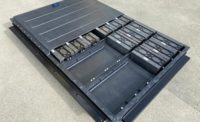DETROIT—General Motors is ramping up its electric vehicle production plans. In fact, the automaker has made a number of recent announcements intended to bolster its EV strategy.
The 35-year-old Detroit-Hamtramck assembly plant will be GM’s first facility that is 100 percent devoted to electric vehicles. In late 2021, it will start building an all-electric GMC Hummer.
In addition, more than 40 percent of GM’s new product launches in China over the next five years will be electrified models.
The heart of GM’s strategy is a modular propulsion system and a highly flexible global EV platform powered by proprietary Ultium batteries. Ultium’s state-of-the-art NCMA (nickel-cobalt-manganese-aluminum) chemistry uses aluminum in the cathode to help reduce the need for rare-earth materials such as cobalt.
The advanced battery chemistry is packed in large, flat pouch cells that enable smart module construction to reduce complexity and simplify cooling needs. Additionally, the battery electronics are incorporated directly into the modules, eliminating nearly 90 percent of the battery pack wiring, compared to GM’s current electric vehicles.
GM also plans to become the first automaker to use an almost completely wireless battery management system (wBMS). The system, developed with Analog Devices Inc., will enable GM to power many different types of electric vehicles from a common set of battery components.
“The wBMS [will drive our] EVs to market faster, as time won’t be needed to develop specific communications systems or redesign complex wiring schemes for each new vehicle,” says Kent Helfrich, executive director of global electrification and battery systems at GM. “Instead, the wBMS helps to ensure the scalability of Ultium batteries across GM’s future lineup, encompassing different brands and vehicle segments, from heavy-duty trucks to performance vehicles.
“Much like the pack design of [our] Ultium batteries, which is flexible enough to incorporate new chemistry over time as technology changes, the wBMS’ basic structure can easily receive new features as software becomes available,” claims Helfrich.
“Scalability and complexity reduction are a theme with our Ultium batteries,” explains Helfrich. “The wireless battery management system is the critical enabler of this amazing flexibility. [It] represents the epitome of Ultium’s configurability and should help [us] build profitable EVs at scale.”
According to Helfrich, the wBMS will help GM’s electric vehicles balance chemistry within the individual battery cell groups for optimal performance. It can also conduct real-time battery pack health checks and refocus the network of modules and sensors as needed to help safeguard battery health over a vehicle’s lifespan.
“By reducing wires within the batteries by up to 90 percent, the wireless system can help extend charging range by creating lighter vehicles overall and opening extra room for more batteries,” Helfrich points out. “The space and flexibility created by this reduction in wires not only enables a cleaner design, but also simpler and more streamlined battery restructuring as needed and more robust manufacturing processes.”
GM also recently formed a strategic partnership with Nikola Corp., a startup that is developing a line of hydrogen-electric vehicles, including heavy-duty trucks. As part of the agreement, Nikola will utilize GM’s Ultium battery system and Hydrotec fuel cell technology. GM will mass-produce battery electric and fuel cell versions of Nikola’s Badger pickup truck.
“We are growing our presence in multiple high-volume EV segments while building scale to lower battery and fuel cell costs and increase profitability,” says Mary Barra, CEO of GM. “In addition, applying [our] electrified technology solutions to the heavy-duty class of commercial vehicles is another important step in fulfilling our vision of a zero-emissions future.”



